AMD Phenom II X4 980 Black Edition Review
by Anand Lal Shimpi on May 2, 2011 10:42 PM ESTGaming Performance
In testing Left 4 Dead we use a custom recorded timedemo. We run on a GeForce GTX 280 at 1680 x 1050 with all quality options set to high. No AA/AF enabled.
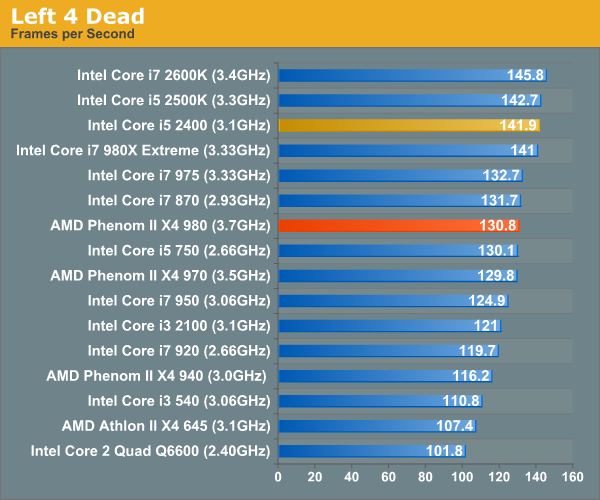
Far Cry 2 ships with several built in benchmarks. For this test we use the Playback (Action) demo at 1680 x 1050 in DX9 mode on a GTX 280. The game is set to medium defaults with performance options set to high.
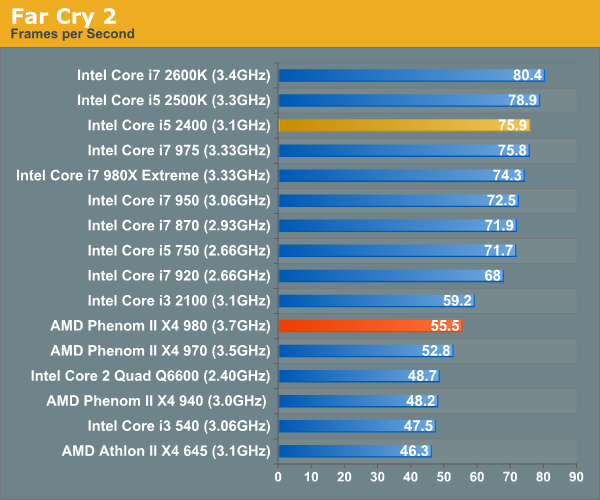
Crysis Warhead also ships with a number of built in benchmarks. Running on a GTX 280 at 1680 x 1050 we run the ambush timedemo with mainstream quality settings. Physics is set to enthusiast however to further stress the CPU.
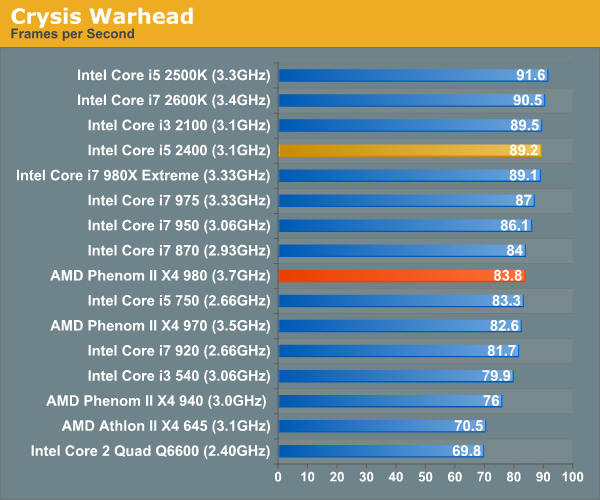
Our Dragon Age: Origins benchmark begins with a shift to the Radeon HD 5870. From this point on these games are run under our Bench refresh testbed under Windows 7 x64. Our benchmark here is the same thing we ran in our integrated graphics tests - a quick FRAPS walkthrough inside a castle. The game is run at 1680 x 1050 at high quality and texture options.
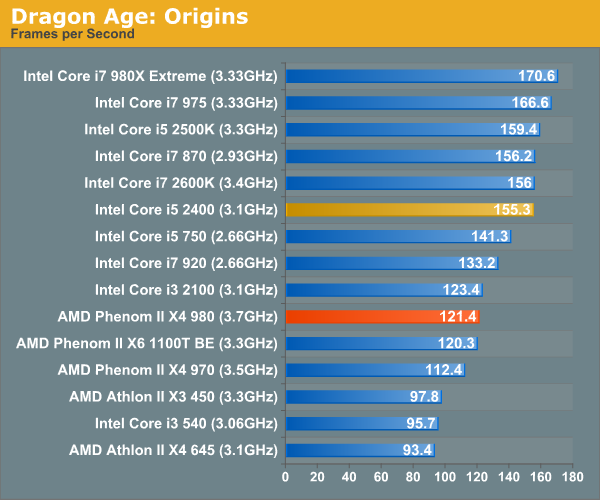
We're running Dawn of War II's internal benchmark at high quality defaults. Our GPU of choice is a Radeon HD 5870 running at 1680 x 1050.
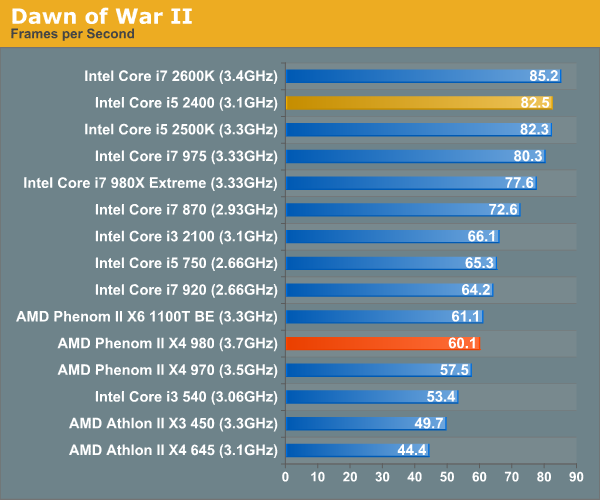
Our World of Warcraft benchmark is a manual FRAPS runthrough of a lightly populated server with no other player controlled characters around. The frame rates here are higher than you'd see in a real world scenario, but the relative comparison between CPUs is accurate.
We run on a Radeon HD 5870 at 1680 x 1050. We're using WoW's high quality defaults but with weather intensity turned down all the way.
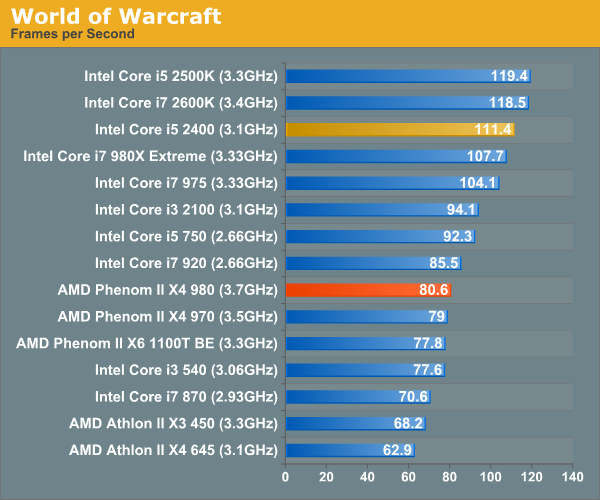
For Starcraft II we're using our heavy CPU test. This is a playback of a 3v3 match where all players gather in the middle of the map for one large, unit-heavy battle. While GPU plays a role here, we're mostly CPU bound. The Radeon HD 5870 is running at 1024 x 768 at medium quality settings to make this an even more pure CPU benchmark.

This is Civ V's built in Late GameView benchmark, the newest addition to our gaming test suite. The benchmark outputs three scores: a full render score, a no-shadow render score and a no-render score. We present the first and the last, acting as a GPU and CPU benchmark respectively.
We're running at 1680 x 1050 with all quality settings set to high. For this test we're using a brand new testbed with 8GB of memory and a GeForce GTX 580.
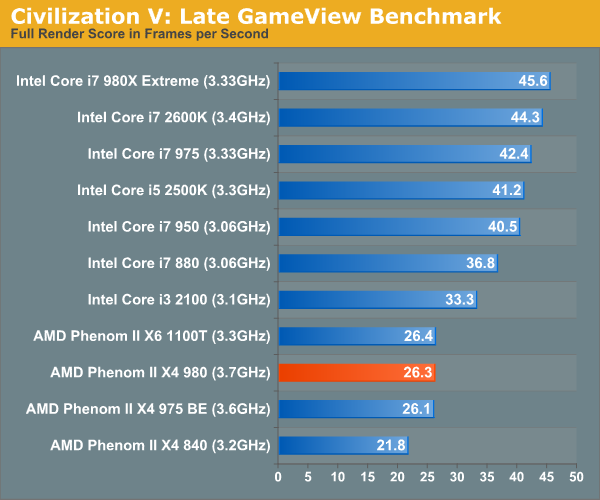
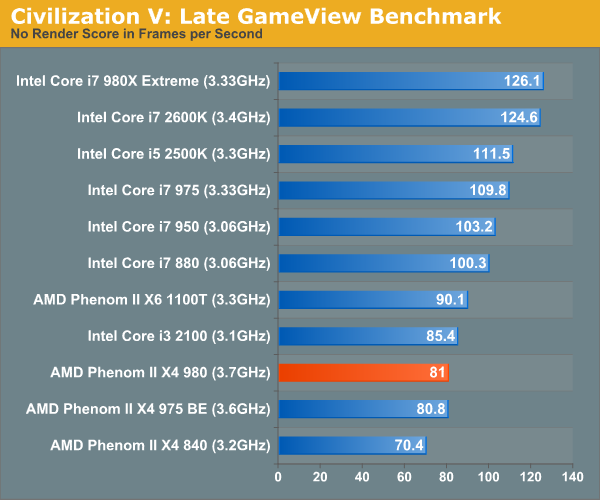










78 Comments
View All Comments
medi01 - Tuesday, May 3, 2011 - link
Now try to make price of CPU + Motherboard equal and compare again.BSMonitor - Tuesday, May 3, 2011 - link
"Now try to make price of CPU + Motherboard equal and compare again."Price is a function of demand. AMD HAS to sell them this cheap to move them at all. They do not sell them as cheap as they do because they are more cost effective to produce, so your comment in this context is completely irrelevant ..
Action_Parsnip - Tuesday, May 3, 2011 - link
You misunderstand his point.kmmatney - Tuesday, May 3, 2011 - link
Yep. I've bought at least 10 cpu+MB combos for $99 at Microcenter over the last year, for clients, friends, and family. Fast enough for most purposes, and you are GPU limited in most games, and so better off spending the cost savings on a better video card. For $300, for can get a much better performing AMD system, versus Intel. Maybe not good for AMD, but good for me.silverblue - Thursday, May 5, 2011 - link
But it doesn't. There's plenty of benchmarks around to show that a comparative Phenom II X4 gets a few wins, especially in encoding. Aside of a few very strong Intel-optimised situations, there's really very little in it, and anyway, if you ignore the very high price of the upper Core 2 Quads, you can get a faster Phenom II X4 or X6 for less.Targon - Tuesday, May 3, 2011 - link
AMD has a new platform on the way, and that is where the focus has been. For now, any new Athlon 2 or Phenom 2 processor will just be a bit more of the same with a higher clock rate, but still has the same exact design as previous chips. Bulldozer on the other hand is the big push to get back to being competitive.The big problem is, and remains the lack of a 32nm fab process which Intel has had for a long time now.
haplo602 - Tuesday, May 3, 2011 - link
thanks for the compilation benchmark. finaly something usable for the Linux folks :-) linux kernel compilation (or open office) would be better, but this is not a bad start ;-)macky_r - Tuesday, May 3, 2011 - link
I knew from the beginning that AMD wants to milk more performance out of it's Deneb architecture. I wasn't surprise when I saw this item on this website that I visit from time to time.I currently own one of the first Deneb CPUs (PH II 965 BE) w/ a clock of 3.4 GHz rated at 140W! I didn't even bother OCing this regretful purchased CPU of mine. How I wish I waited for the cooler versions, but I was in a hurry to build a PC that I can use at home for my Networking classes
I will buy the 1100T soon. I will be be OCing it at 3.7 GHz w/ turbo core disabled.
I don't wanna be negative, but I know for a fact that Bulldozer will not beat Intel's upcoming LGA 2011 CPUs. Maybe Bulldozer is meant to compete with Sandy-Bridge.
Griswold - Tuesday, May 3, 2011 - link
Yea, you know for a fact...BSMonitor - Tuesday, May 3, 2011 - link
"I don't wanna be negative, but I know for a fact that Bulldozer will not beat Intel's upcoming LGA 2011 CPUs. Maybe Bulldozer is meant to compete with Sandy-Bridge"Exactly. Even if. Look at the turbo boost scenarios from the Intel SNB processors. There is so much headroom on these processors. Intel is already holding back performance because of lack of competition.
Intel has silicon running stock air-cooled 4GHz and beyond in house, guaranteed.